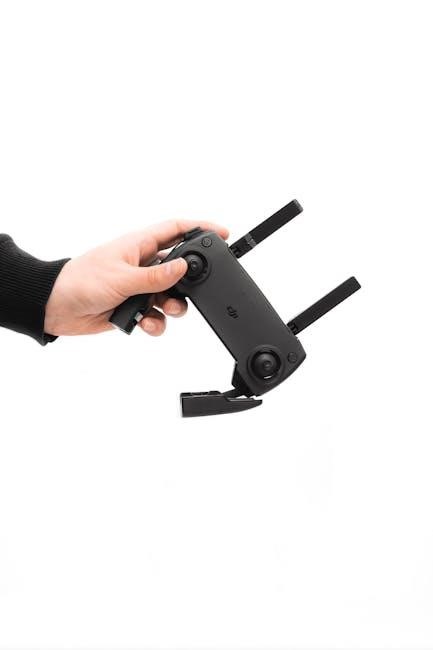Welcome to the comprehensive guide for FAR: Changing Tides‚ detailing all 35 trophies‚ including the Platinum․ Discover tips‚ strategies‚ and insights to unlock every achievement seamlessly․
Overview of the Game and Trophy System
FAR: Changing Tides features a trophy system with 35 achievements‚ including 1 Platinum‚ 3 Gold‚ 17 Silver‚ and 14 Bronze trophies․ The game’s trophies are designed to reward both story progression and optional challenges‚ such as exploration‚ puzzle-solving‚ and upgrading your vessel․ Most trophies are tied to completing specific tasks or reaching milestones‚ while others encourage players to explore off-the-beaten-path locations or master navigation skills․ The trophy system is user-friendly‚ with clear objectives‚ making it accessible for players of all skill levels to aim for the Platinum trophy‚ which requires unlocking all other achievements․
Importance of Trophies in FAR: Changing Tides
Trophies in FAR: Changing Tides serve as both rewards and guides‚ encouraging exploration and mastery of the game’s mechanics․ They highlight key achievements‚ such as completing challenging sections or upgrading your vessel‚ and provide a sense of accomplishment․ Trophies also act as a roadmap‚ directing players to hidden areas and optional challenges they might otherwise miss․ Earning all trophies unlocks the coveted Platinum‚ a testament to completing the game fully․ This system enhances replayability and motivates players to explore every aspect of the world‚ ensuring a fulfilling experience․

Platinum Trophy: “Changed Tides”
The Platinum Trophy‚ “Changed Tides‚” is the ultimate achievement‚ awarded upon earning all other trophies․ It symbolizes completing FAR: Changing Tides entirely․
Requirements for Unlocking the Platinum Trophy
To unlock the Platinum Trophy‚ “Changed Tides‚” you must earn all other trophies in the game․ This includes completing the story‚ achieving all optional challenges‚ and discovering hidden items․ Upgrading your vessel fully and mastering navigation are also essential․ Ensure you manage resources effectively and overcome every difficult section․ While the journey is straightforward‚ some trophies are missable‚ so attention to detail is key․ Use checkpoints and save points wisely to avoid missing any achievements․ This comprehensive approach ensures you unlock the ultimate reward for FAR: Changing Tides․
Estimated Time to Achieve Platinum
Achieving the Platinum Trophy in FAR: Changing Tides is estimated to take around 6 hours․ The game’s straightforward narrative and manageable challenges contribute to this relatively short timeframe․ Completing the story‚ optional challenges‚ and discovering hidden items are the primary tasks․ Speedrunners can complete the game even faster‚ while casual players may take a bit longer to explore thoroughly․ With focused play and efficient navigation‚ unlocking the Platinum Trophy is both achievable and rewarding within this timeframe․

Gold Trophies
Earn three gold trophies by passing through the Sea Gate‚ using the crane effectively‚ and releasing the vessel․ These milestones mark significant progress in the game․
“Seafarer” ― Passing Through the Sea Gate
To unlock the “Seafarer” trophy‚ navigate your vessel through the Sea Gate‚ a pivotal early milestone․ Ensure precise control and alignment to pass successfully․ Use the map to identify the correct path and avoid obstacles․ This achievement marks your first major progression and is considered straightforward․ Timing and accuracy are key; practice if needed․ Completion rewards you with the “Seafarer” trophy‚ symbolizing your journey’s beginning․ Checkpoint saves can help if you fail‚ allowing retries without significant progress loss․ This trophy is a foundational step toward earning the Platinum․ Focus on steady navigation to overcome this challenge efficiently․
“Are You Qualified for That?” ⸺ Using the Crane
Earn the “Are You Qualified for That?” trophy by successfully operating the crane to clear obstacles․ Locate the crane early in the game‚ interact with it‚ and follow on-screen prompts to activate and maneuver it effectively․ Precision is crucial as improper use may fail the objective․ Completion grants the trophy‚ highlighting your mechanical aptitude․ This achievement is moderate in difficulty‚ requiring attention to detail and practice․ Utilize checkpoints to retry if needed․ Mastering the crane is essential for progression and a step closer to the Platinum trophy․ Ensure you complete this challenge to maintain uninterrupted advancement․
“Cast Off” ⸺ Releasing the Vessel
Unlock the “Cast Off” trophy by successfully releasing the vessel into the water․ This achievement occurs early in the game‚ marking a pivotal moment in your journey․ Ensure the vessel is fully prepared‚ with sails and engines in optimal condition; Follow the in-game instructions to initiate the launch sequence․ Timing and precision are key to a smooth release․ Once accomplished‚ the trophy is awarded‚ celebrating your progress․ This milestone sets the stage for further exploration and challenges‚ guiding you toward the Platinum trophy․ Keep your vessel well-maintained to ensure continued success in your adventure․

Silver Trophies
Earn silver trophies by mastering navigation‚ solving puzzles‚ and upgrading your vessel․ These achievements highlight skill and dedication‚ contributing to your ultimate Platinum goal․
“Exploring the Unknown” ― Discovering Hidden Locations
Unlock the “Exploring the Unknown” trophy by venturing off the beaten path and discovering hidden locations throughout your journey․ Use your map to identify unexplored areas and interact with environmental objects to reveal secrets․ This achievement rewards curiosity and thorough exploration․ Pay attention to subtle clues like unusual landmarks or slightly ajar doors․ Exploring these hidden spots not only aids in progression but also enriches your understanding of the game’s world․ Remember‚ some areas may require specific upgrades or maneuvers to access‚ making exploration a rewarding challenge․
“Master Navigator” ― Completing Navigation Challenges
Earn the “Master Navigator” trophy by excelling in navigation challenges throughout FAR: Changing Tides․ This silver trophy requires precise sailing‚ map-reading skills‚ and strategic decision-making․ Successfully navigate through treacherous waters‚ avoid obstacles‚ and reach checkpoints efficiently․ Optimize your vessel’s speed and sail orientation to tackle these challenges swiftly․ Completing these trials not only grants the trophy but also enhances your sailing prowess‚ essential for progressing through the game․ Focus on mastering navigation early to streamline your journey and unlock this achievement with confidence․
“Puzzle Solver” ⸺ Solving Complex Puzzles
Unlock the “Puzzle Solver” silver trophy by conquering the intricate puzzles in FAR: Changing Tides․ Each puzzle requires careful observation‚ creativity‚ and logical thinking․ From deciphering environmental clues to manipulating machinery‚ these challenges test your problem-solving skills․ Use your wits to overcome obstacles‚ activate mechanisms‚ and progress through the story․ Pay attention to details in your surroundings‚ as they often hold the key to solving these brain teasers․ Completing these puzzles not only rewards you with the trophy but also deepens your connection to the game’s narrative and world;
“Upgrade Mastery” ⸺ Upgrading the Vessel Fully
Earn the “Upgrade Mastery” silver trophy by fully upgrading your vessel in FAR: Changing Tides․ Gather resources scattered across the world to unlock and purchase enhancements․ Upgrades include improved speed‚ maneuverability‚ and durability‚ essential for tackling challenging sections․ Regularly check your vessel’s status and prioritize upgrades that suit your playstyle․ Completing this achievement not only enhances gameplay but also showcases your dedication to optimizing your ship‚ preparing it for the toughest journeys ahead and ensuring a smoother experience throughout your adventure․

Bronze Trophies
Discover the diverse Bronze Trophies in FAR: Changing Tides‚ each rewarding exploration‚ skill‚ and perseverance․ From “First Voyage” to “Voyager‚” unlock these by completing specific tasks and milestones․
“First Voyage” ⸺ Completing the Initial Journey
Earn the “First Voyage” Bronze Trophy by completing the initial journey in FAR: Changing Tides․ This trophy is awarded for guiding your character through the introductory sequence and reaching the first major checkpoint․ It serves as an introduction to the game’s mechanics and sets the stage for the adventures ahead․ The trophy is straightforward and requires no special skills‚ making it a great starting point for new players․ Simply follow the on-screen instructions and progress through the opening section to unlock this achievement․ It marks the beginning of your journey and is a foundational step toward earning the Platinum Trophy․
“Curiosity” ⸺ Interacting with Environmental Objects
Unlock the “Curiosity” Bronze Trophy by interacting with various environmental objects throughout FAR: Changing Tides․ This trophy encourages exploration and engagement with the game’s world․ From examining ancient ruins to manipulating machinery‚ each interaction contributes to your progress․ The trophy is easily achievable by thoroughly investigating your surroundings during your journey․ Keep an eye out for glowing indicators or unique objects that can be interacted with․ This trophy rewards your inquisitive nature and adds to your collection as you delve deeper into the game’s captivating environment․
“Skillful Maneuver” ⸺ Performing Precision Sailing
Earn the “Skillful Maneuver” Bronze Trophy by showcasing your sailing prowess in FAR: Changing Tides․ This trophy requires navigating through tight spaces or avoiding obstacles with precision․ Timing your movements and adjusting sails or engines effectively is key; Practice in calm waters before tackling tricky passages․ Pay attention to environmental cues and use your vessel’s tools wisely․ Mastery of these maneuvers not only unlocks this trophy but also enhances your overall sailing skills‚ making exploration smoother and more enjoyable throughout your journey․
“Survival Instinct” ― Managing Resources Effectively
Secure the “Survival Instinct” Bronze Trophy by efficiently managing your resources in FAR: Changing Tides․ Monitor fuel‚ water‚ and repair materials to ensure you never run out during critical moments․ Regularly check your vessel’s condition and replenish supplies at safe harbors or through exploration․ Balancing resource usage with exploration and progress is vital․ This trophy rewards careful planning and attention to detail‚ ensuring your journey remains uninterrupted by scarcity․ Effective management not only aids in survival but also allows for a more immersive and successful adventure․
“Discovery” ⸺ Finding Secret Areas
Earn the “Discovery” Bronze Trophy by uncovering hidden locations throughout FAR: Changing Tides․ These secret areas often contain valuable resources and lore․ Keep a sharp eye out for subtle environmental clues‚ such as unusual landforms or glowing markers‚ which indicate the presence of hidden paths․ Utilize your map and compass to navigate off the beaten track‚ and don’t hesitate to explore mysterious sites․ Each discovered location brings you closer to this trophy and enriches your understanding of the game’s world․ Exploration is key to unlocking its secrets․
“Perseverance” ― Overcoming Difficult Sections
The “Perseverance” Bronze Trophy is awarded for conquering challenging sections in FAR: Changing Tides․ These segments test your sailing skills and patience․ To unlock this trophy‚ focus on precise navigation‚ optimal use of your vessel’s upgrades‚ and resource management․ Stay calm under pressure and retry difficult areas until you succeed․ Each overcome obstacle brings you closer to this achievement and demonstrates your mastery of the game’s mechanics․ Persistence is key to unlocking this rewarding trophy․
“Completionist” ⸺ Collecting All In-Game Items
Earning the “Completionist” Bronze Trophy requires collecting every in-game item in FAR: Changing Tides․ This includes hidden lore entries‚ upgrades‚ and secret treasures․ Thoroughly explore each area‚ interact with environmental objects‚ and complete side quests to ensure no item is missed․ Use your map to track uncollected items and revisit locations as needed; Patience and a keen eye for detail are essential․ Once all items are gathered‚ the trophy will unlock‚ showcasing your dedication to fully experiencing the game’s world and story․
“Speed Runner” ― Completing Levels Quickly
The “Speed Runner” Bronze Trophy challenges players to complete levels as swiftly as possible in FAR: Changing Tides․ To achieve this‚ optimize your sailing techniques by maximizing speed and efficiently navigating through checkpoints․ Avoid unnecessary detours and focus on the main objectives․ Utilize upgrades to enhance your vessel’s performance‚ enabling faster traversal․ Practice timing and precision to shave seconds off your completion times․ Consistent effort and strategic planning are key to unlocking this trophy and proving your skills as a swift navigator;
“Explorer” ⸺ Mapping the Entire World
Earning the “Explorer” Bronze Trophy requires mapping 100% of FAR: Changing Tides’ world․ This involves venturing off the beaten path to uncover hidden areas and secret locations; Use your vessel’s navigation tools to chart every region thoroughly․ Keep an eye out for undiscovered islands‚ underwater ruins‚ and other points of interest․ Regularly check your map to ensure no sections remain unexplored․ Patience and thorough exploration are essential to completing this achievement and unlocking the full beauty of the game’s vast environment․
“Challenger” ⸺ Completing Optional Challenges
Unlock the “Challenger” Bronze Trophy by completing all optional challenges scattered throughout FAR: Changing Tides․ These challenges‚ such as precision sailing trials and puzzle mini-games‚ test your skills and knowledge of the game mechanics․ Each challenge rewards unique insights into the world and its lore․ To achieve this trophy‚ explore every nook and cranny‚ engage with environmental objects‚ and participate in side activities․ Completing these challenges not only earns you the trophy but also enriches your overall gaming experience by revealing hidden details and enhancing your mastery of the vessel․
“Historian” ⸺ Unlocking All Lore Entries

Earn the “Historian” Bronze Trophy by uncovering every lore entry in FAR: Changing Tides․ These entries‚ hidden across the world‚ provide deep insights into the game’s universe‚ characters‚ and events․ To achieve this trophy‚ thoroughly explore each area‚ interact with ancient ruins‚ and decode mysterious artifacts․ Each discovered entry adds a piece to the narrative puzzle‚ rewarding your curiosity and dedication․ Completing this trophy not only enriches your understanding of the story but also showcases your commitment to fully experiencing the game’s world․
“Adventurer” ― Completing Side Quests
Unlock the “Adventurer” Bronze Trophy by completing all side quests in FAR: Changing Tides․ These optional missions offer unique challenges and rewards‚ enhancing your gameplay experience․ Each side quest provides opportunities to explore new areas‚ interact with intriguing characters‚ and uncover hidden lore․ Ensure you thoroughly examine each location and engage with NPCs to discover and complete every available quest․ This trophy reflects your dedication to exploring beyond the main storyline‚ contributing to a richer understanding of the game’s world and its inhabitants․
“Voyager” ⸺ Traveling Long Distances
Earn the “Voyager” Bronze Trophy by traversing vast distances across the game’s expansive world․ This achievement rewards your exploration spirit and commitment to discovering new horizons․ Sail through diverse environments‚ from serene coastlines to challenging open seas‚ ensuring you cover significant mileage․ Utilize your vessel’s upgrades to enhance speed and endurance‚ making long journeys more manageable․ Keep track of your progress and aim to explore every nook and cranny․ This trophy signifies your mastery of navigation and dedication to uncovering the game’s hidden gems․
“Navigator” ⸺ Using the Map Effectively
The “Navigator” Bronze Trophy is awarded for effectively utilizing the map to chart your course and uncover hidden secrets․ This achievement emphasizes the importance of navigation skills‚ encouraging players to explore off the beaten path․ By carefully studying the map‚ you can identify uncharted territories‚ optimize your route‚ and discover new locations․ Regularly updating your map and using landmarks will aid in efficient traversal․ This trophy highlights your ability to navigate seamlessly and make the most of the game’s vast‚ open world․

Trophy Tips and Tricks
Mastering FAR: Changing Tides requires strategic planning‚ efficient resource management‚ and thorough exploration; Utilize checkpoints‚ upgrade your vessel‚ and explore off the beaten path to unlock all trophies seamlessly․
Using Checkpoints and Save Points
Regularly utilizing checkpoints and save points in FAR: Changing Tides ensures you don’t lose progress․ Save frequently‚ especially before challenging sections or resource-intensive areas․ Checkpoints serve as respawn points‚ allowing you to retry difficult parts without significant setbacks․ For trophy hunting‚ saving before key decisions or interactions can help avoid missing achievements․ Use these systems strategically to manage resources‚ track progress‚ and efficiently work toward unlocking all trophies without unnecessary repetition or lost time․
Optimizing Sailing and Navigation
Mastering sailing techniques is crucial for efficient navigation in FAR: Changing Tides․ Ensure your sails are always at maximum capacity and aligned with the wind direction to maintain speed․ Use the rudder wisely to steer through tight spaces and avoid obstacles․ Regularly check the map to plan your route‚ minimizing detours and saving time․ Upgrading your vessel’s hull and sails can significantly improve handling and speed‚ making exploration smoother․ Optimize your navigation by leveraging environmental clues‚ such as tides and landmarks‚ to reach destinations swiftly and effortlessly‚ enhancing your overall progress and trophy achievements․
Upgrading Your Vessel for Better Performance
Upgrading your vessel is essential for tackling challenges in FAR: Changing Tides․ Prioritize hull upgrades to increase durability and reduce damage from collisions․ Enhance sail efficiency to maximize speed and maneuverability‚ especially in open waters․ Install a better rudder for tighter turns and improved control․ Add storage compartments to carry more resources‚ ensuring longer exploration without resupplying․ Regular maintenance and timely repairs prevent mid-voyage breakdowns․ Allocate resources wisely to balance offensive and defensive upgrades‚ ensuring your vessel is well-rounded for various scenarios‚ ultimately aiding in trophy unlocks and smoother gameplay progression․
Exploring Off the Beaten Path
Exploring hidden locations in FAR: Changing Tides is crucial for discovering secret areas and unlocking trophies․ Use your map to identify uncharted regions and venture into mysterious zones․ Keep an eye out for landmarks‚ puzzles‚ or interactive objects that hint at undiscovered paths․ Curiosity often rewards players with unique lore entries or items․ Don’t hesitate to deviate from the main route‚ as these detours often lead to unexpected achievements․ Thorough exploration enhances your understanding of the game’s world and aids in completing challenges‚ making it a key strategy for trophy hunters․

Missable Trophies and How to Avoid Them
Identify missable trophies early‚ such as those tied to specific story choices or one-time events․ Use chapter select to revisit missed opportunities and ensure all achievements are earned without restarting the game entirely․
Identifying Missable Trophies Early
Several trophies‚ such as “Seafarer” and “Are You Qualified for That?”‚ are tied to specific story moments or actions․ These can be easily missed if not addressed during initial playthrough․ To avoid this‚ thoroughly explore each chapter‚ interact with environmental objects‚ and complete optional challenges promptly․ Use the chapter select feature to revisit areas where trophies might have been overlooked․ Keep track of progress for achievements like “Explorer” and “Historian‚” which require extensive exploration and lore collection․ Early identification ensures a smoother path to unlocking all trophies without redundant gameplay․
Chapter Select Feature for Missed Trophies
The chapter select feature in FAR: Changing Tides is a valuable tool for retrieving missed trophies․ After completing the game‚ players can revisit specific chapters to unlock achievements they may have overlooked․ This feature is particularly useful for trophies tied to exploration‚ such as “Discovery” and “Explorer‚” which require finding secret areas or mapping the entire world․ By reloading a chapter‚ you can focus solely on the objectives needed for the missed trophies‚ ensuring efficient progression without replaying the entire game․ This feature enhances accessibility and minimizes frustration for completionists aiming for the Platinum trophy․

Speedrun Tips for Fast Platinum
Optimize your playthrough by focusing on essential objectives and skipping non-essential content․ Utilize the chapter select feature to revisit missed trophies‚ ensuring a streamlined path to Platinum․
Optimizing Your Playthrough
To achieve the Platinum trophy quickly‚ focus on completing the story while tackling optional objectives․ Manage resources like fuel and sails efficiently‚ and upgrade your vessel strategically․ Use checkpoints to save progress and avoid unnecessary detours․ Prioritize trophies tied to exploration and navigation early‚ as these can be time-consuming․ Skip non-essential interactions and focus on main challenges․ Utilize the chapter select feature to revisit missed trophies post-game․ Streamline your journey by following a structured path‚ ensuring minimal backtracking․ This approach ensures a smooth and efficient path to unlocking all achievements in FAR: Changing Tides․
Skipping Non-Essential Content
To speedrun effectively‚ focus on story progression and essential trophy requirements․ Avoid extensive exploration of non-critical areas unless necessary for hidden trophies․ Skip optional environmental interactions and unnecessary resource gathering once you’ve met requirements․ Don’t linger on side quests or excessive upgrading unless directly tied to achievements․ Streamline your journey by bypassing non-essential dialogue and cutscenes․ This approach saves significant time‚ allowing you to concentrate on unlocking the Platinum trophy efficiently in FAR: Changing Tides․
Easily unlock all trophies in FAR: Changing Tides with this comprehensive guide‚ ensuring a smooth journey to the Platinum trophy and a fulfilling gaming experience․
Final Tips for Achieving All Trophies
To efficiently unlock all trophies in FAR: Changing Tides‚ focus on exploring every nook and cranny‚ as hidden locations and secrets often reward achievements․ Regularly upgrade your vessel to improve performance‚ which aids in completing navigation challenges and puzzles․ Utilize checkpoints and save points to track your progress and avoid missing any collectibles or challenges․ Be patient and methodical in your playthrough‚ ensuring you interact with environmental objects and complete side quests․ With dedication and careful planning‚ earning the Platinum trophy is achievable‚ making your journey through the game’s stunning world even more rewarding and memorable․
Enjoying the Journey in FAR: Changing Tides
FAR: Changing Tides offers a captivating experience‚ blending exploration‚ puzzles‚ and stunning visuals․ To fully enjoy the journey‚ take time to appreciate the intricate world design and immerse yourself in its serene atmosphere․ Engage with every environmental detail‚ as these interactions often lead to hidden secrets and trophy unlocks․ Balancing trophy hunting with natural progression ensures a stress-free adventure․ Remember‚ the game’s beauty lies not just in its challenges but in its ability to tell a story through its landscape‚ making every moment a rewarding part of your voyage․

About the Author
The author is a dedicated gamer with extensive experience in trophy hunting and game completion․ Specializing in detailed guides‚ they provide clear‚ concise strategies for achieving success in FAR: Changing Tides․
Expertise in Trophy Guides and Game Completion
With years of experience‚ the author specializes in creating detailed trophy guides‚ ensuring players can efficiently unlock achievements․ Their expertise covers all trophy types‚ from Bronze to Platinum‚ providing step-by-step strategies and tips for optimal progression․ By focusing on both story-driven and optional challenges‚ the guide offers comprehensive coverage of FAR: Changing Tides․ The author’s dedication to clarity and precision helps gamers of all skill levels achieve 100% completion‚ making the journey to the Platinum trophy both enjoyable and stress-free․






























